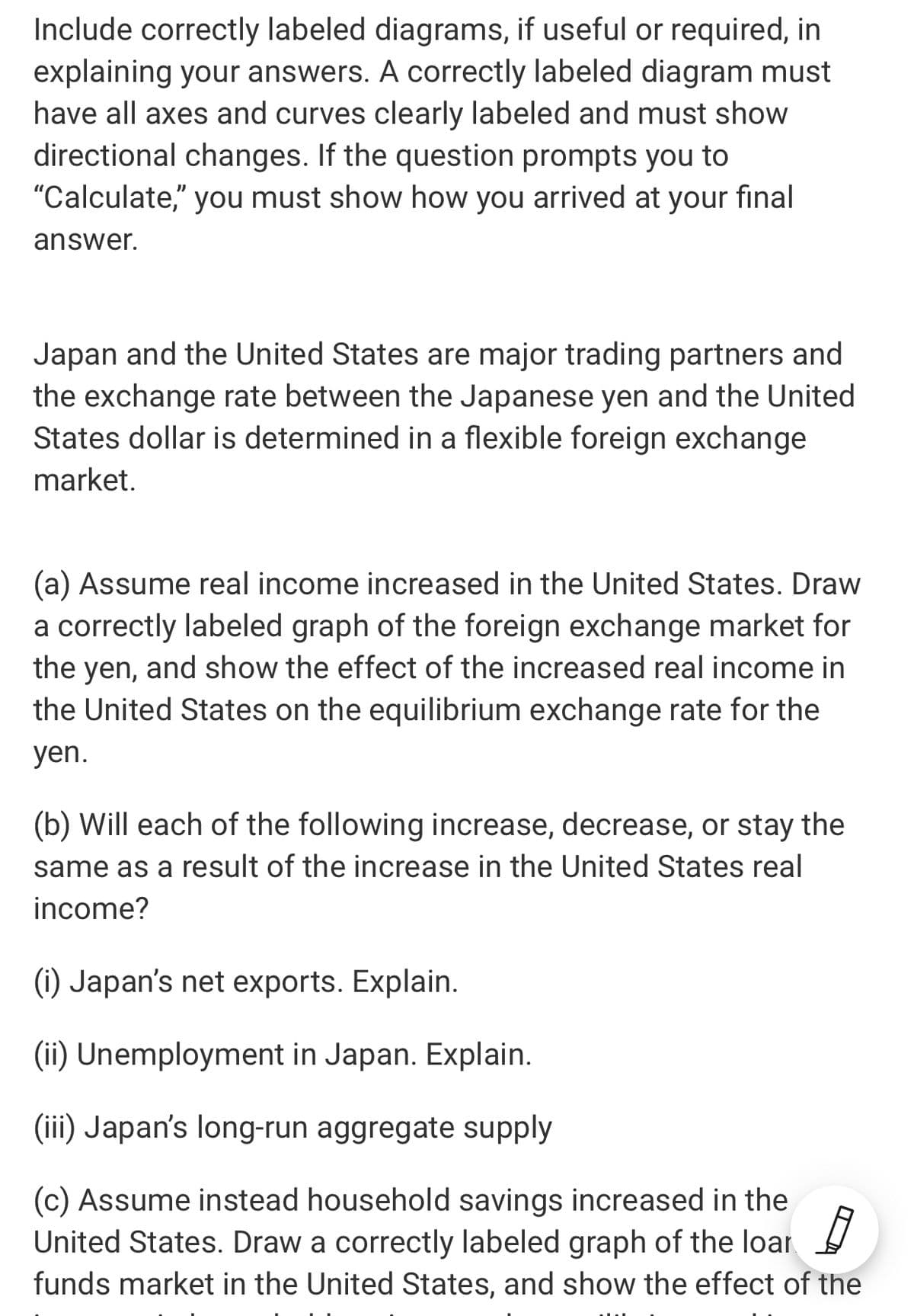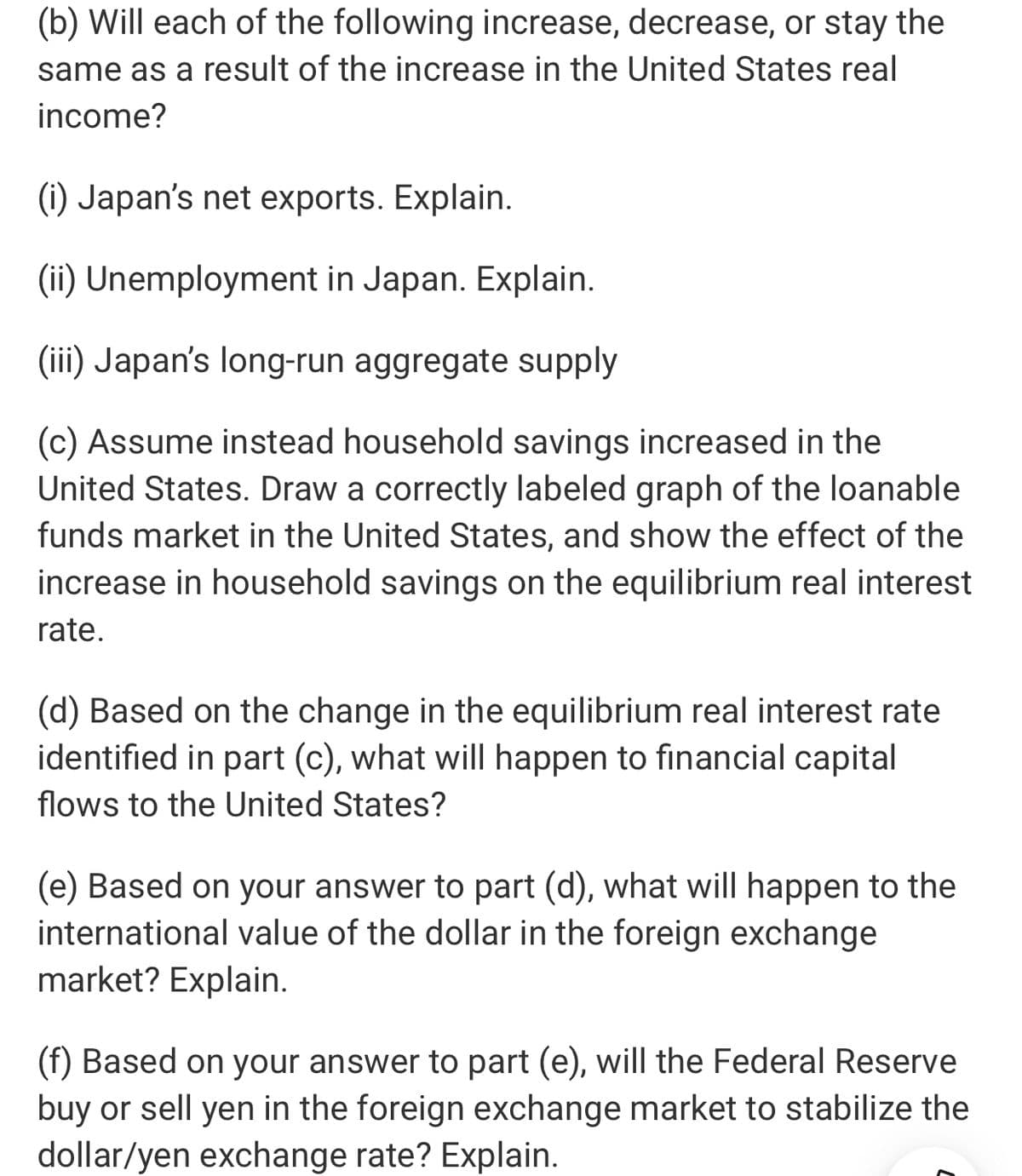Include correctly labeled diagrams, if useful or required, in explaining your answers. A correctly labeled diagram must have all axes and curves clearly labeled and must show directional changes. If the question prompts you to "Calculate," you must show how you arrived at your final answer. Japan and the United States are major trading partners and the exchange rate between the Japanese yen and the United States dollar is determined in a flexible foreign exchange market. (a) Assume real income increased in the United States. Draw a correctly labeled graph of the foreign exchange market for the yen, and show the effect of the increased real income in the United States on the equilibrium exchange rate for the yen. (b) Will each of the following increase, decrease, or stay the same as a result of the increase in the United States real income? (i) Japan's net exports. Explain. (ii) Unemployment in Japan. Explain. (iii) Japan's long-run aggregate supply (c) Assume instead household savings increased in the United States. Draw a correctly labeled graph of the loar. funds market in the United States, and show the effect of the
Include correctly labeled diagrams, if useful or required, in explaining your answers. A correctly labeled diagram must have all axes and curves clearly labeled and must show directional changes. If the question prompts you to "Calculate," you must show how you arrived at your final answer. Japan and the United States are major trading partners and the exchange rate between the Japanese yen and the United States dollar is determined in a flexible foreign exchange market. (a) Assume real income increased in the United States. Draw a correctly labeled graph of the foreign exchange market for the yen, and show the effect of the increased real income in the United States on the equilibrium exchange rate for the yen. (b) Will each of the following increase, decrease, or stay the same as a result of the increase in the United States real income? (i) Japan's net exports. Explain. (ii) Unemployment in Japan. Explain. (iii) Japan's long-run aggregate supply (c) Assume instead household savings increased in the United States. Draw a correctly labeled graph of the loar. funds market in the United States, and show the effect of the
Chapter1: Making Economics Decisions
Section: Chapter Questions
Problem 1QTC
Related questions
Question
100%

Transcribed Image Text:Include correctly labeled diagrams, if useful or required, in
explaining your answers. A correctly labeled diagram must
have all axes and curves clearly labeled and must show
directional changes. If the question prompts you to
"Calculate," you must show how you arrived at your final
answer.
Japan and the United States are major trading partners and
the exchange rate between the Japanese yen and the United
States dollar is determined in a flexible foreign exchange
market.
(a) Assume real income increased in the United States. Draw
a correctly labeled graph of the foreign exchange market for
the yen, and show the effect of the increased real income in
the United States on the equilibrium exchange rate for the
yen.
(b) Will each of the following increase, decrease, or stay the
same as a result of the increase in the United States real
income?
(1) Japan's net exports. Explain.
(ii) Unemployment in Japan. Explain.
(iii) Japan's long-run aggregate supply
(c) Assume instead household savings increased in the
United States. Draw a correctly labeled graph of the loar
funds market in the United States, and show the effect of the

Transcribed Image Text:(b) Will each of the following increase, decrease, or stay the
same as a result of the increase in the United States real
income?
(i) Japan's net exports. Explain.
(ii) Unemployment in Japan. Explain.
(iii) Japan's long-run aggregate supply
(c) Assume instead household savings increased in the
United States. Draw a correctly labeled graph of the loanable
funds market in the United States, and show the effect of the
increase in household savings on the equilibrium real interest
rate.
(d) Based on the change in the equilibrium real interest rate
identified in part (c), what will happen to financial capital
flows to the United States?
(e) Based on your answer to part (d), what will happen to the
international value of the dollar in the foreign exchange
market? Explain.
(f) Based on your answer to part (e), will the Federal Reserve
buy or sell yen in the foreign exchange market to stabilize the
dollar/yen exchange rate? Explain.
Expert Solution
This question has been solved!
Explore an expertly crafted, step-by-step solution for a thorough understanding of key concepts.
This is a popular solution!
Trending now
This is a popular solution!
Step by step
Solved in 2 steps with 2 images

Knowledge Booster
Learn more about
Need a deep-dive on the concept behind this application? Look no further. Learn more about this topic, economics and related others by exploring similar questions and additional content below.Recommended textbooks for you


Principles of Economics (12th Edition)
Economics
ISBN:
9780134078779
Author:
Karl E. Case, Ray C. Fair, Sharon E. Oster
Publisher:
PEARSON

Engineering Economy (17th Edition)
Economics
ISBN:
9780134870069
Author:
William G. Sullivan, Elin M. Wicks, C. Patrick Koelling
Publisher:
PEARSON


Principles of Economics (12th Edition)
Economics
ISBN:
9780134078779
Author:
Karl E. Case, Ray C. Fair, Sharon E. Oster
Publisher:
PEARSON

Engineering Economy (17th Edition)
Economics
ISBN:
9780134870069
Author:
William G. Sullivan, Elin M. Wicks, C. Patrick Koelling
Publisher:
PEARSON

Principles of Economics (MindTap Course List)
Economics
ISBN:
9781305585126
Author:
N. Gregory Mankiw
Publisher:
Cengage Learning

Managerial Economics: A Problem Solving Approach
Economics
ISBN:
9781337106665
Author:
Luke M. Froeb, Brian T. McCann, Michael R. Ward, Mike Shor
Publisher:
Cengage Learning

Managerial Economics & Business Strategy (Mcgraw-…
Economics
ISBN:
9781259290619
Author:
Michael Baye, Jeff Prince
Publisher:
McGraw-Hill Education